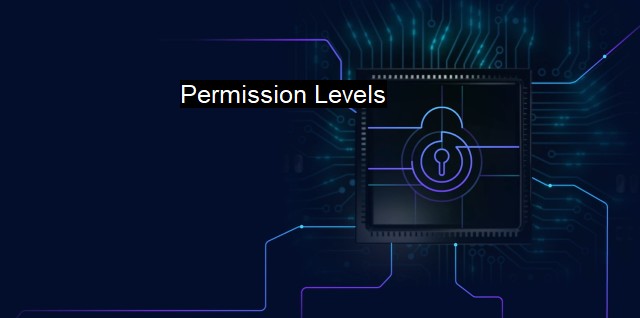What are Permission Levels?
Understanding Permission Levels in Cybersecurity: Managing Access and Control on a Computer Network
"Permission Levels" is a major term within the field of cybersecurity and antivirus - an intrinsic part of the technological safety measures which govern the operations of a computing system. Predicated upon the concept of authorizing individuals or processes specific privileges during the interaction with technology, Permission Levels function as key control points ensuring the integrity, confidentiality, and availability of digital resources.To understand this critical security concept, consider the structure of your typical organization. Human resources (HR), tech-support, accountancy, management, and other departments operate in the same domain but require tightly defined, uniquely tailored access privileges to complete their respective tasks. Fundamentally, Permission Levels enable the creation of these distinct digital roles, granting employees disparate engagement 'rights' with the information and computing resources provided by the business. The mechanism sets the ground rules for what can be done, by whom, and under what circumstances.
Permission Levels primarily apply to users, applications, regular files, scripts, and directories within the system. With these security protocols, for instance, a standard user may not have the required administrative privileging to install software on a given system. Accounting teams might gain access to sensitive financial information unattainable to others, while those restricted from executing specific scripts may lack the rights to potentially harmful processes. This tenant becomes especially critical in an era of sophisticated malware and cyber-security threats executed through tricking victims into enabling script execution.
Cybersecurity threats are a relentless reality in the evolving digital realm. Unauthorized access to networks, applications, databases, and sensitive data can bring profound financial repercussions, simply hemorrhaging business reputation. Here the key freezes on the term: unauthorized access. By judiciously controlling Permission Levels, an organization can drastically diminish these risks.
Permission Levels operate under a pseudo-umbrella designation known as the Access Control Models, further developing the imported cybersecurity aspect. Discretionary access control (DAC), role-based access control (RBAC), and mandatory access control (MAC) represent the three primary categories. DAC awards users discretion to allow or deny access to their files; RBAC assigns permissions based on roles within an organization; MAC pits these privileges against security policies and sensitivity labels attached to the data and the users.
Tracking back to antivirus and its intersection with Permission Levels - the mechanism proves vital. To run an antivirus scan or frozen-era disk cleanup, a user often needs administrator privileges. Similarly, installing system-wide antivirus software requires escalated privileging - ensuring that these critical cybersecurity tools touch all system nooks and can oust lurking threats.
Antivirus software generates its breed of cybersecurity concerns. Should a virus, Trojan, or any malicious program will itself into having the same Permission Level with the antivirus software, it'd gain wide-spread control, corrupting, modifying, or deleting network and system files.
Winning the war against cyber threats and maintaining digital integrity requires a formidable toolset - and assigned permission levels stand boldly within these ranks. Balancing accessibility with legitimate user needs fetched from operation requirements, Permission Levels contribute capably to nurturing safe business environments and protecting critical data from unscrupulous hands in the thriving electronic age.
The repercussions of irrespective handling of Permission Levels should be weighed heavily. Compromised access controls can create gaping holes in cybersecurity defenses, inviting cyber-attackers to exploit exposed vulnerabilities, steal sensitive data and disrupt your business operations.
Conversely, when appropriately managed, Permission levels allow robust control over who can view, edit, or delete specific files and systems, enforcing security measures that are an integral part of any reliable cyber defense strategy. Carefully designed and judiciously implemented Permission Levels, interwoven with effective access management and thought-out use of antivirus, can sway the balance in any cybersecurity infrastructure and mark the difference between secure operations and disastrous breaches.

Permission Levels FAQs
What are permission levels in cybersecurity and antivirus software?
Permission levels in cybersecurity and antivirus software are a way of controlling access to certain features or functions within the software. These levels determine the level of access or control that a user or program has over the system.What are the different levels of permission in cybersecurity and antivirus software?
The different levels of permission include user level, administrator level, and system level. User level permissions allow access only to basic features and functions, while administrator level permissions provide more access to system settings and controls. System level permissions provide complete control over the system and are typically reserved for the antivirus or system administrator.How are permission levels determined in cybersecurity and antivirus software?
Permission levels in cybersecurity and antivirus software are determined by the software developer and configured during installation or setup. The default settings may be adjusted by the user or system administrator to provide more or less access to certain features or functions.Why are permission levels important in cybersecurity and antivirus software?
Permission levels are important in cybersecurity and antivirus software because they help to prevent unauthorized access, control, or modification of the system. By limiting access to certain features or functions, the system can be more secure and protected from malware, viruses, and other cyber threats.| | A | | | B | | | C | | | D | | | E | | | F | | | G | | | H | | | I | | | J | | | K | | | L | | | M | |
| | N | | | O | | | P | | | Q | | | R | | | S | | | T | | | U | | | V | | | W | | | X | | | Y | | | Z | |
| | 1 | | | 2 | | | 3 | | | 4 | | | 7 | | | 8 | | |||||||